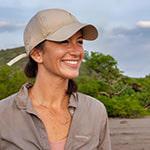
Carolina Ángela Soto-Navarro, Ph.D.
Carolina is a Conservation Scientist with over 15 years of experience working extensively in the conservation, environment, capacity development, and environmental sustainability sectors. Throughout her career, she has built relationships with conservation leaders, NGOs, and donor organizations worldwide and understands what drives successful, high-impact conservation programs. Her focus lies on delivering successful environmental outcomes based on robust science and through cross-sectorial engagement and knowledge exchange.
Having worked across a range of sectors, including research institutions, NGOs, the private sector, multilateral agencies, and statutory bodies, she possesses a strong understanding of how to design conservation programs and partnerships that effectively tackle complex and challenging environmental issues. She strives for a game-changing impact in biodiversity conservation by designing innovative and transdisciplinary conservation action programs that inspire positive engagement, mainstream biodiversity conservation to the top of the political agenda, and impact priority biodiversity outcomes for the benefit of nature and people.
What sparked an interest in her area of research?
Her interests range from charity effectiveness and the future of conservation practice to the potential for rewilding as a transformational solution to many current and forthcoming conservation challenges. Her current scientific research focuses on prioritizing climate lifeboats across the Tropics and operationalizing conservation to maximize co-benefits for climate change and biodiversity loss. She works primarily in the Global South, collaborating closely with conservation practitioners worldwide and colleagues in other disciplines, including economics and human development.
What is one of your favorite moments in the field?
My favorite moment in the field was when I heard for the first time the unique song of a couple of the world’s second rarest ape, the Cao Vit gibbon, on its last stronghold on Earth, a patch of old-growth forest in the border between China and Vietnam. We trekked for three days through the hardest environment I have ever been to, the northernmost limestone forests of Vietnam, bordering China, in the Ngoc Con Trung Khanh Cao Bang region, a military area closed to tourism. When we reached our base camp the following morning, a group of gibbons erupted into song at dawn, giving me the most magical wildlife moments in my life so far. There are less than 200 individuals of Cao Vit gibbon left on Earth. That’s the same as the number of people you might see in a single carriage train while commuting to work!
Education
- Ph.D. in Ecology, Spanish National Research Council (CSIC) (Ministry of Science and Innovation) and University of Seville, Seville (Spain.
- MSc in Conservation Biology, University of Seville, Spain.
- MSc in Science and Education, University of Seville, Spain.
